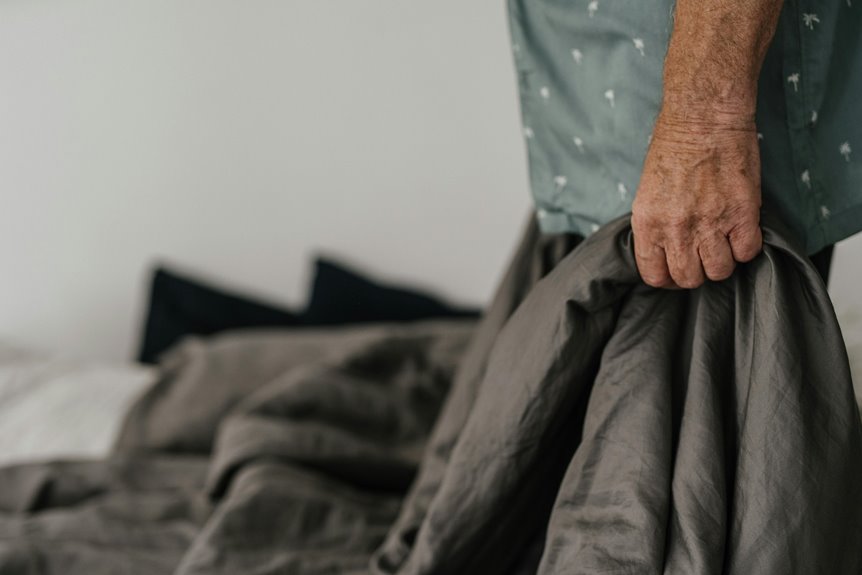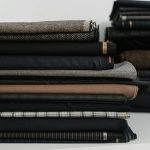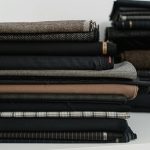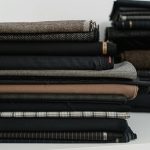Cotton is a natural fiber from plants, while percale refers to a specific tight, plain weave often used with cotton. So, when you choose cotton, you get softness and breathability, but percale adds a crisp, cool texture with enhanced durability. Percale tends to feel lightweight and smooth, perfect for warmer climates. Understanding these differences helps you pick the best sheets for comfort and longevity. Keep exploring to find out how they affect care, feel, and sleep quality.
Table of Contents
Key Takeaways
- Cotton is a natural fiber, while percale refers to a specific tight, plain weave applied to cotton fabric.
- Percale offers a crisp, cool texture, whereas cotton fabric generally feels softer and warmer.
- Percale fabric is more breathable and durable due to its higher thread count and weave structure.
- Cotton sheets soften with washing, while percale maintains a smooth, matte finish and resists pilling.
- Care differs: percale benefits from cooler washes and ironing, whereas cotton is easier to care for overall.
Understanding Cotton as a Fabric
Although you might take it for granted, cotton remains one of the most popular natural fabrics worldwide due to its softness, breathability, and durability.
When you choose cotton, you’re picking a material that’s made from natural fibers grown in cotton plants. These fibers are spun into yarn and then woven or knitted into fabric.
You benefit from cotton’s ability to absorb moisture, keeping you comfortable in warm weather. Plus, it’s hypoallergenic, making it ideal if you have sensitive skin.
Cotton fabrics are also easy to care for; you can machine wash and dry them without much fuss.
Whether it’s in your clothing, bedding, or towels, cotton offers a reliable, natural option that balances comfort and practicality perfectly.
What Defines Percale Weave?
You’ll notice that percale weave stands out because of its simple, crisscross pattern that creates a smooth, matte finish.
Thread count plays a key role here, as a higher count means a tighter, more durable fabric.
Understanding these details helps you recognize why percale feels crisp and breathable compared to other weaves.
Weave Pattern Explained
When you look closely at percale, you’ll notice its distinct weave pattern sets it apart from other fabrics. Percale uses a simple, tight, one-over-one-under weave that creates a matte finish and a crisp feel. This pattern guarantees durability and breathability, making percale sheets popular for warm climates.
Here’s a quick look at how percale’s weave compares to others:
| Feature | Percale Weave |
|---|---|
| Weave Type | Plain weave (one-over-one-under) |
| Texture | Smooth, crisp |
| Breathability | High |
This straightforward pattern gives percale its signature cool touch and balanced strength, ideal if you want fresh, breathable bedding that lasts.
Thread Count Importance
Percale’s crisp feel and durability come not only from its weave but also from its thread count.
When you look for percale sheets, you’ll often see thread counts ranging from 200 to 400. This range guarantees the fabric remains breathable and lightweight, avoiding the heavy, dense feel you might get with higher thread counts.
While a higher thread count can seem appealing, percale’s signature qualities depend on a balanced count that keeps the fabric crisp and cool.
If the thread count is too low, the fabric might feel rough or less durable. Too high, and you lose the breathability percale’s known for.
Percale Fabric Characteristics
A percale weave features a simple, tight one-over-one-under pattern that creates a smooth, matte finish. You’ll notice percale fabric is crisp, breathable, and durable because of this weave. It’s perfect if you prefer a cool, lightweight feel in your bedding or clothes. Percale’s structure also means it resists pilling and wears well over time, maintaining its fresh look.
Here’s a quick comparison to help you understand percale’s defining traits:
| Feature | Percale Fabric |
|---|---|
| Weave Pattern | One-over-one-under (plain) |
| Texture | Smooth, crisp, matte |
| Durability | High; resists pilling and wear |
This straightforward weave is what sets percale apart from other cotton fabrics.
How Cotton and Percale Are Related
Although cotton and percale serve different roles in textiles, they share a close relationship that directly affects the fabric’s feel and quality.
Cotton and percale, though distinct, closely influence fabric texture and overall quality.
When you look at percale, you’re actually seeing a specific type of weave applied to cotton fibers. Cotton is the raw material—the natural fiber harvested from cotton plants—while percale refers to how those fibers are woven together.
So, percale fabric is often made from cotton, but not all cotton fabrics use the percale weave. This weave creates a tighter, crisper texture that enhances cotton’s breathability and durability.
When you choose percale sheets, you’re selecting cotton that’s been woven in a particular way to maximize comfort and longevity. Understanding this connection helps you pick the right fabric based on your needs.
The Feel and Texture Differences
When you run your hand over cotton and percale fabrics, you’ll notice distinct differences in texture that influence your comfort.
Cotton feels soft and smooth, often with a slight natural warmth. It has a gentle, cozy touch that many find inviting, especially if it’s brushed or combed cotton.
Percale, on the other hand, has a crisp, cool feel thanks to its tight, plain weave. It feels lightweight and slightly textured, giving a fresh, matte finish rather than a sheen.
You’ll find percale less stretchy and more structured compared to typical cotton fabrics.
Choosing between them depends on whether you prefer a soft, plush sensation or a crisp, cool touch against your skin, as these textural differences shape how each fabric feels throughout the day.
Breathability and Cooling Properties
Two key factors make cotton and percale stand out regarding breathability and cooling.
First, their natural fibers allow air to circulate, keeping you comfortable.
Second, the weave structure plays a huge role in how cool you feel.
Here’s what you should know:
- Cotton’s natural fibers absorb moisture, wicking sweat away from your skin.
- Percale’s tight, plain weave creates a crisp, cool surface that feels invigorating.
- Percale generally offers better airflow due to its lightweight, breathable weave.
- Both materials help regulate temperature, but percale is often preferred in warmer climates.
When choosing bedding, consider how both cotton and percale can keep you cool and comfortable throughout the night, especially if you tend to overheat.
Durability and Longevity Comparison
Beyond keeping you cool, the durability of your bedding plays a big role in long-term satisfaction.
Cotton fibers are naturally strong and can handle frequent washing and daily use without wearing out quickly. However, percale, a type of cotton weave, tends to be even more durable due to its tight, plain weave structure. This weave creates a firm fabric that resists pilling and thinning better than some other cotton weaves.
If you want bedding that maintains its crisp texture and lasts for years, percale is a solid choice. That said, the quality of the cotton used matters too—long-staple cotton like Egyptian or Pima enhances durability regardless of the weave.
Care and Maintenance Tips
Although both cotton and percale require regular care to stay fresh and comfortable, their maintenance needs differ slightly.
Cotton’s natural fibers can handle warmer washes, while percale’s tight weave benefits from gentler handling to maintain its crisp feel.
Here are four care tips to keep your sheets in top shape:
- Wash cotton sheets in warm water with mild detergent to remove dirt without damaging fibers.
- Use cold or cool water for percale sheets to preserve their texture and prevent shrinkage.
- Avoid high heat drying; instead, tumble dry on low or air dry to prevent weakening the fabric.
- Iron percale sheets if you want to restore that crisp finish; cotton usually needs less ironing.
Following these steps helps your sheets last longer and stay comfortable.
Common Uses for Cotton and Percale Sheets
When choosing sheets, understanding how cotton and percale perform in different settings can help you pick the best option for your needs.
Cotton sheets are incredibly versatile, making them a popular choice for everyday use. They’re soft, breathable, and comfortable, perfect for all seasons and ideal if you want a cozy, slightly warmer feel.
Cotton sheets offer soft, breathable comfort year-round, ideal for a cozy and slightly warmer sleeping experience.
Percale sheets, on the other hand, are crisp and lightweight, which makes them great for warmer climates or if you tend to sleep hot. You’ll often find percale in hotels and summer homes because of its cool, fresh feel.
Both options work well in guest rooms or master bedrooms, but your choice depends on whether you prefer that smooth, crisp texture of percale or the soft, natural warmth of cotton.
Choosing the Right Option for Your Sleep Needs
When choosing between cotton and percale, think about how each fabric feels against your skin.
You’ll also want to contemplate durability and breathability to match your sleep preferences.
Understanding these factors helps you pick the best sheets for a comfortable night.
Fabric Feel Comparison
Since your sleep quality depends heavily on fabric feel, understanding the difference between cotton and percale can help you choose the best option.
Cotton feels soft and smooth, offering a cozy touch that’s perfect if you like a gentle, warm fabric. Percale, on the other hand, has a crisp, cool texture due to its tight weave, giving you a revitalizing feel, especially in warmer months.
Here’s a quick comparison to help you decide:
- Cotton feels plush and comforting, ideal for cooler nights.
- Percale feels lightweight and crisp, great if you prefer breathable sheets.
- Cotton often softens with use, becoming even more inviting.
- Percale maintains its firmness, providing a neat, wrinkle-resistant look.
Choose based on whether you want softness or a crisp finish.
Durability and Breathability
Durability and breathability play essential roles in how your sheets perform night after night.
Cotton sheets, especially those made from long-staple fibers like Egyptian or Pima, tend to be highly durable and get softer with each wash.
Percale, a type of cotton weave, is known for its crisp feel and exceptional breathability. If you tend to sleep hot or live in a warm climate, percale’s breathable weave helps keep you cool by allowing better airflow.
On the durability front, percale’s tight plain weave offers solid resistance to wear and tear, making it a strong choice for everyday use.
Ultimately, if you want long-lasting sheets that breathe well, percale cotton is a smart pick. For softness combined with durability, standard cotton options work well too.
Frequently Asked Questions
Are Cotton and Percale Sheets Hypoallergenic?
You’ll find cotton sheets naturally hypoallergenic, making them great if you have sensitive skin. Percale, a type of cotton weave, shares this benefit, so both can help reduce allergens and keep you comfortable while you sleep.
Is Percale Suitable for All Seasons?
Imagine crisp, cool nights and warm summer days—percale’s breathability keeps you comfortable year-round. You’ll love its lightweight feel in summer and invigorating coolness, but in winter, you might want extra layers for cozy warmth.
Can Percale Be Made From Fibers Other Than Cotton?
Yes, percale can be made from fibers other than cotton, like polyester or blends. You’ll find these options offer durability and affordability, though they might feel less breathable compared to 100% cotton percale sheets.
Do Cotton and Percale Fabrics Shrink After Washing?
Of course, your fabrics won’t shrink—if you don’t wash them! Cotton and percale both tend to shrink a bit after washing, so you’ll want to follow care instructions carefully to keep them fitting just right.
Which Is More Eco-Friendly: Cotton or Percale?
You’ll find organic cotton more eco-friendly since it’s natural and biodegradable. Percale refers to weave, often made from cotton, so its eco-impact depends on the fiber source and production methods used.
- Does Chiffon Fabric Stink - July 15, 2025
- Does Chiffon Fabric Affect the Economy - July 15, 2025
- Does Cotton Fabric Have a Nap - July 15, 2025







